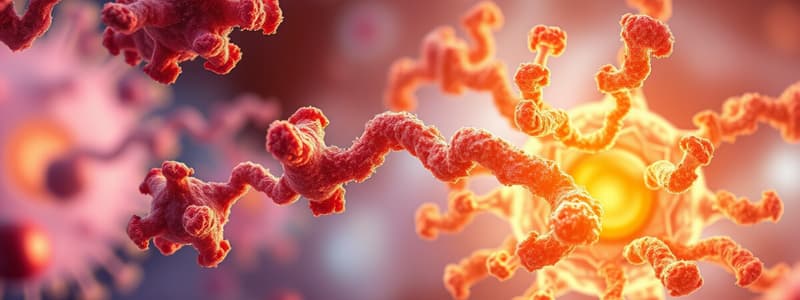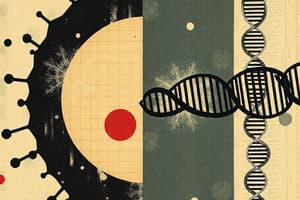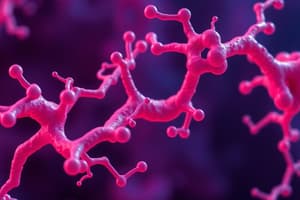Podcast
Questions and Answers
Which organelle is primarily responsible for synthesizing proteins?
Which organelle is primarily responsible for synthesizing proteins?
- Mitochondria
- Ribosomes (correct)
- Endoplasmic Reticulum
- Golgi Apparatus
What role do carbohydrates play in the cell membrane?
What role do carbohydrates play in the cell membrane?
- Energy storage
- Regulating transport
- Cell recognition and communication (correct)
- Structural support
Which organelle is involved in the production of ATP from carbohydrates?
Which organelle is involved in the production of ATP from carbohydrates?
- Mitochondria (correct)
- Lysosomes
- Golgi Apparatus
- Ribosomes
What is the primary function of the Golgi Apparatus in relation to proteins?
What is the primary function of the Golgi Apparatus in relation to proteins?
Which biological macromolecule is responsible for storing genetic information?
Which biological macromolecule is responsible for storing genetic information?
What is a key function of the Smooth Endoplasmic Reticulum?
What is a key function of the Smooth Endoplasmic Reticulum?
Which of the following enzymes is found in lysosomes to aid in breaking down waste?
Which of the following enzymes is found in lysosomes to aid in breaking down waste?
Which type of macromolecule aids in catalyzing biochemical reactions?
Which type of macromolecule aids in catalyzing biochemical reactions?
What roles do carbohydrates play in cells?
What roles do carbohydrates play in cells?
Which statement accurately describes the properties of proteins?
Which statement accurately describes the properties of proteins?
What is the primary function of enzymes in biological reactions?
What is the primary function of enzymes in biological reactions?
Which of the following describes anabolic reactions?
Which of the following describes anabolic reactions?
Which process occurs in the thylakoid membranes during photosynthesis?
Which process occurs in the thylakoid membranes during photosynthesis?
What are the inputs for cellular respiration?
What are the inputs for cellular respiration?
What is the role of the Electron Transport Chain in mitochondria?
What is the role of the Electron Transport Chain in mitochondria?
What characteristic of ATP makes it an effective energy carrier?
What characteristic of ATP makes it an effective energy carrier?
Flashcards are hidden until you start studying
Study Notes
Biological Macromolecules
-
Proteins:
- Found in organelles like the nucleus, ribosomes, and Golgi apparatus; essential for DNA packaging, protein synthesis, and modification.
- Serve diverse functions such as catalyzing reactions (enzymes), providing structural support, and regulating processes.
-
Carbohydrates:
- Located in the cytoplasm (as glucose), cell membrane (as glycoproteins and glycolipids), and stored as glycogen (animals) or starch (plants).
- Key for energy storage, supply, and facilitating cell recognition and signaling.
-
Lipids:
- Major components of cell membranes, forming a lipid bilayer for structure and regulation of cell entry/exit.
- Synthesized in the smooth ER and modified in the Golgi apparatus; essential for energy storage and signaling.
-
Nucleic Acids:
- Primarily found in the nucleus (DNA) and ribosomes (RNA); DNA encodes genetic information whereas RNA plays a role in protein synthesis.
- Mitochondria contain their own DNA crucial for ATP production.
Properties of Proteins and Enzymes
-
Proteins:
- Composed of amino acids linked by peptide bonds and have unique three-dimensional structures that determine their function.
- Exhibit properties such as specificity and the ability to denature, highlighting their functional diversity.
-
Enzymes:
- Specific types of proteins that act as biological catalysts, accelerating chemical reactions without being consumed.
- Lower activation energy for reactions, facilitating processes necessary for life.
Anabolic vs. Catabolic Reactions
-
Anabolic Reactions:
- Synthesize larger molecules from smaller units; they require energy inputs.
- Examples include protein synthesis and photosynthesis.
-
Catabolic Reactions:
- Break down larger molecules into smaller units, releasing energy in the process.
- Common examples include cellular respiration and digestion.
Photosynthesis
-
Chemical Formula:
- Inputs: 6 CO₂ + 6 H₂O + light energy
- Outputs: C₆H₁₂O₆ + 6 O₂
-
Light-Dependent Reactions:
- Occur in thylakoid membranes; convert light energy into ATP and NADPH while releasing oxygen.
-
Light-Independent Reactions (Calvin Cycle):
- Take place in the stroma; utilize ATP and NADPH to synthesize glucose from CO₂.
-
Chloroplast Structure:
- Composed of an outer membrane, inner membrane, stroma, and thylakoids arranged in grana.
Cellular Respiration
-
Chemical Formula:
- Inputs: C₆H₁₂O₆ + 6 O₂
- Outputs: 6 CO₂ + 6 H₂O + ATP energy.
-
Mitochondria Structure:
- Features an outer membrane, inner membrane with cristae, intermembrane space, and mitochondrial matrix.
-
ATP Production Cycle:
- ATP is generated through the Electron Transport Chain and Chemiosmosis during oxidative phosphorylation.
-
ATP Properties:
- Functions as the primary energy carrier in cells; composed of adenine, ribose, and three phosphate groups.
- Hydrolysis of ATP to ADP releases energy for cellular activities.
Experimentation
-
Interpreting Experimental Data:
- Analyze data trends, compare experimental groups, and evaluate hypotheses for support.
-
Drawing Appropriate Graphs:
- Select graph types that best represent data relationships and results, supporting effective visualization of findings.
Studying That Suits You
Use AI to generate personalized quizzes and flashcards to suit your learning preferences.




